Do you know how to get the best from your GoPro underwater? Are you planning your next diving holiday in Indonesia? GoPro’s and other action cams are incredible pieces of equipment for capturing your memories and dives on video. To ensure that your video footage does you justice, here are some easy to implement tips which will ensure you take home videos and images which you can be proud of.
Seal the Deal:
Make sure that there is no dirt on the white rubber seal which sits inside the door to your GoPro. Dirt on the seal (even a human hair) can cause the case to leak. To ensure that you get a good seal, make sure that the backdoor is completely pushed into the housing, before clamping the black latch. Applying a tiny amount of silicone grease to the seal will also help. It is important to note that GoPro seals are less elastic than regular camera housing O-rings and constantly taking them out of the housing and stretching them when you put them back can cause them to stretch out of shape, so try to keep yours as clean as possible at all times by never leaving the door open – this will mean you do not need to remove it so often for a full clean.
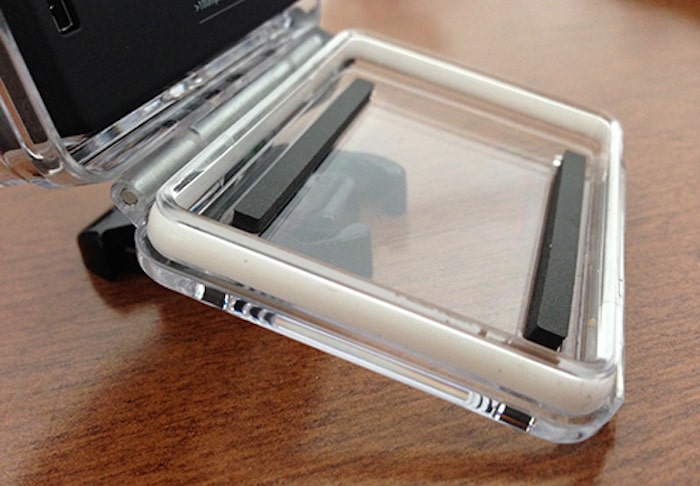
Inspect the seal (O-ring) prior to closing the door and apply silicone grease
Clean the lens:
Take a minute before closing the case and make sure that there are no fingerprints or dust on your camera lens. And don’t forget to check the housing lens as well (inside and out).
Select your underwater settings:
Before taking your GoPro underwater, make sure your settings are suitable for what you are hoping to achieve. Two settings which can be great underwater, depending on what you want to capture are Video and Timelapse. For point of video (POV), we recommend the 1080 SuperView at 80fps. For still photos, the time lapse setting can be very handy and gives you plenty of shots to work with post-dive. For best results, shoot at the highest resolution possible and at either one image every 0.5 or 1 second.
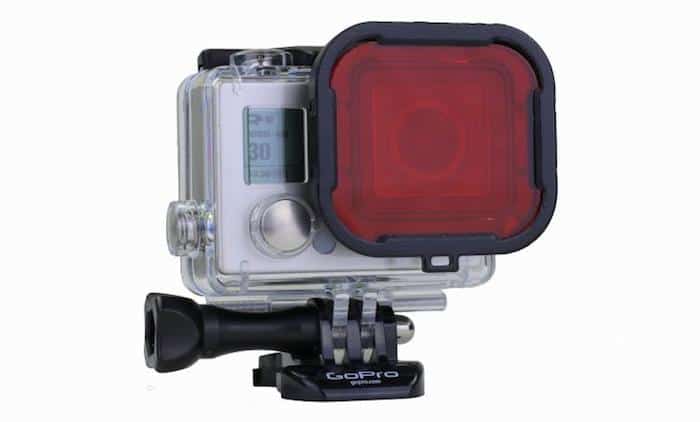
Using a red filter on your GoPro underwater will help correct colours
Use a GoPro underwater red filter or video lights to enhance colours:
As divers, we know that the first colour from the spectrum which we lose underwater is red. Using a red filter will add the red back into your images and video meaning that you avoid shots and footage which is “blued-out”. An alternative to a filter (but more expensive) is to invest in video lights. Artificial lighting will undoubtedly improve your imaging and videos but will also require purchasing a tray on which to mount your Go Pro and lights.
Keep your GoPro steady:
It can be hard to hold a GoPro steady due to its small size – and for people with large hands, it’s easy to capture your fingertips in the edges of the image. If you aren’t going to mount the camera on your chest or head – we recommend using a camera rig (tray) or selfie stick. Note: If you are using a head mount, be sure to remove it before your mask at the end of the dive. Many Go Pros have been lost by divers who have removed their mask first and dislodged the head mount in the process!
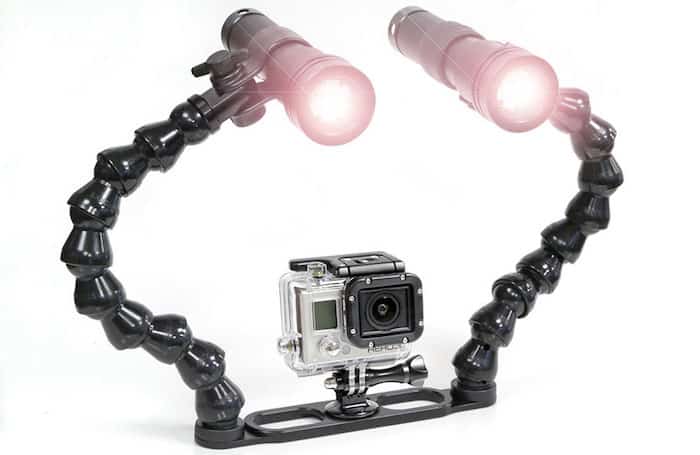
Using a rig or tray will enable you to mount lights and keep the GoPro steady
Keep your subject at least 12 inches away:
Unless you’re using a macro lens on your GoPro underwater, try to keep your subject a minimum of 12 inches from your lens. Any closer and it will be blurry.
Shoot with the sun behind you:
Without a flash when using your GoPro underwater, it’s pretty hard to get a good shot shooting into the sun – it will usually be underexposed and dark. The only exception to this rule is if you are using video lights which will illuminate the subject regardless.
Avoid a fogged up housing:
Anti-fog inserts will absorb any humidity in the air. Without these special inserts, the humidity may condense on the inside surface of the case – especially on the lens. When using anti-fog inserts be extremely careful that they are not preventing the housing from fully sealing when you close and latch the door.
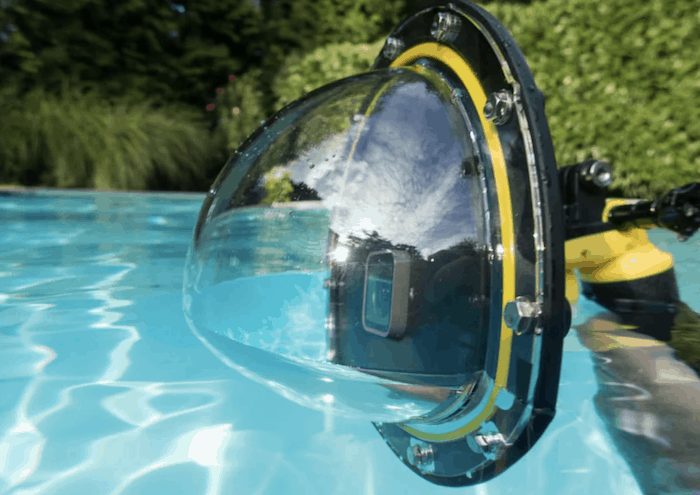
Using a dome port enables you to capture “split” images
Use a dome port:
A dome port is necessary if you want to shoot incredible half underwater and half above the surface photos (also known as “split images”). By moving the water line away from the lens, you’re able to get a photo showing both above and below the water. A dome port can also be used for shooting underwater.
When you surface, you’ll probably want to keep shooting. If you aren’t careful, you’re going to find distorting water droplets on your port. Do as you would with your scuba mask and rub some saliva on the dome port to ensure droplets are repelled and run off.
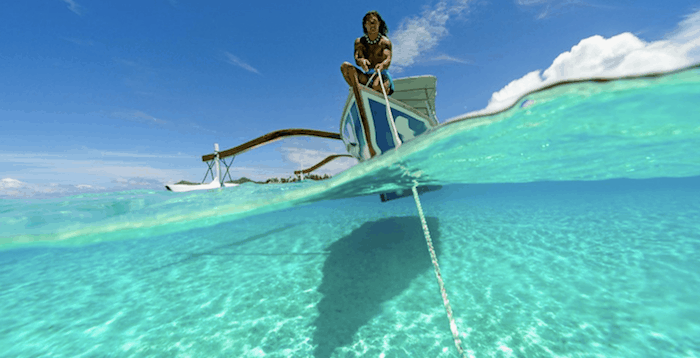
Split images are half underwater and half surface shots
Rinse the housing in fresh water after diving:
Take care of your GoPro and your GoPro will take care of you! You should thoroughly rinse the housing in fresh water to remove any salt residue. Salt can have a corrosive effect – and the last thing you’ll want is to have a damaged/weakened case or seal. A single grain of salt can also prevent the seal from doing its job and result in a leak.
Where to dive in Indonesia with your GoPro:
Indonesia is home to some of the best dive sites in the world – which you will definitely want to capture on your GoPro! Did you know that the Lembeh Strait offers the chance to see some of the rarest and most unusual marine life on the planet? Did you know that when you stay at any Two Fish Divers resort in Indonesia we have rinse tanks for your camera and accessories, staff on hand to give helpful advice and who love to watch your footage at the end of the day? If you are hoping to see big fish during your trip and put your GoPro’s wide-angle capabilities to the test then what could be better than shooting manta rays and mola around Nusa Lembongan or hammerheads at Belongas Bay in South Lombok? For colourful reefs and resident turtles, check out Two Fish Divers Bunaken and Gili Air, and if you want to record your dives on a World War II shipwreck then diving the US Liberty near our Amed resort is a must. One thing is for sure, wherever you choose to dive with us, you’ll be returning home with reams of incredible video footage and images!
To find out more about diving in Indonesia and staying with us, or to make a reservation, fill in the contact form below and we’ll get right back to you.
We look forward to welcoming you to Two Fish Divers again soon.







